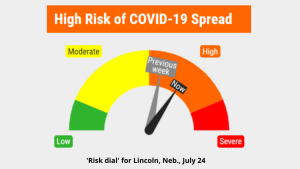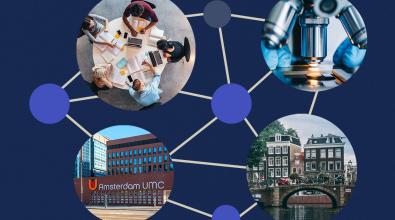How data-driven innovation is fueling cities’ COVID response

Lincoln, Neb., was one of the first cities to launch a color-coded “risk dial” to help residents understand local COVID-19 risks. Launched in May, the speedometer-like alert system points to green when the risk is low, yellow when it’s moderate, orange when it’s high, and red when it’s severe. It also offers concrete recommendations for what precautions residents should be taking at each level.
“As we come to grips with what it means to live our lives with the novel coronavirus in our midst,” Mayor Leirion Gaylor Baird said at the time, the COVID risk dial will “provide the public a data-driven approach that goes beyond the cold calculus of whether or not there is a ventilator or ICU bed waiting for you if you get sick.”
Since then, cities across the country have reached out to Baird and her team for advice on how they can set up something similar. The dial is updated weekly as new data comes in on key metrics, such as case trends, turnaround time on testing results, and the effectiveness of contact tracing. After starting out in the high-risk orange zone, the dial dropped down to yellow in June, back up to orange again in early July, and moved up a notch closer to red last week. The status is reported regularly by local media and watched closely by residents, businesses, and other community organizations.
“We’re not trying to be too fancy here,” said Scott Holmes, Environmental Health Manager for the Lincoln/Lancaster County Health Department. “It’s a fairly simple tool to let our community know where we’re at in the outbreak.”
The risk dial may be a simple tool, but that simplicity is built on years of investment Lincoln has made in its data and innovation capacities. The city accelerated that work through its involvement with What Works Cities, an initiative that elevates the importance of data-informed decision-making in city halls. More recently, Mayor Baird and a number of her staff have received additional training in using data through their participation in the Bloomberg Harvard City Leadership Initiative.
All of it has helped build a stronger response to COVID-19 at a time when analytics and data skills have never been more important. “In the Health Department, every staff person knows how to read the data and what the program is expected to do based on it,” said Raju Kakarlapudi, the Epidemiology Supervisor with the Health Department. He added that Mayor Baird is particularly grounded in the numbers. “She’s said, ‘Inform me with data and evidence, and we will drive the city policy based on what the Health Department advises.”
Lincoln is not the only city showing that investments in their capacity to gather, analyze, act around, and communicate data are paying off in the pandemic. In San Pedro, Mexico, a suburb of Monterey, Mayor Miguel Treviño has been pushing for a more data-driven approach in the year and a half since he came into office. This year, the city hired two analysts and a coordinator for its new data and evidence team, who work with Innovation Secretary Dinorah Cantú-Pedraza on tackling city problems in new ways.
A good example is domestic violence. Until recently, the agency in charge of this had all of its information stored in a single, aging computer. Cantú-Pedraza brought that department and others whose work intersects with the problem together to share their data, store it in a common format, and create a clearer picture of the situation. Then COVID-19 hit, and domestic violence suddenly took on a new dimension and urgency.
Social distancing meant that domestic violence victims, the vast majority of them women, were increasingly stuck at home with their abusers. To give them a quiet way to privately call for help, San Pedro turned to a chatbot that acts as an extension of the city’s service call center.
It works through WhatsApp, the text-messaging platform ubiquitously used by city residents. Send a message to the city’s account, and a ’bot named “Sam” writes back with a menu of city services; one of them is specifically for domestic violence victims to have a police officer immediately sent to their door. The back end of the chatbot also ties in to the new systems Cantú-Pedraza and her colleagues have been setting up to keep tracking data up to date.
In just two months since the service launched, there’s been a surge in domestic violence reports. Of 65 cases reported in May and June, 34 of them, or slightly more than half, came in through the new Sam chatbot. While City Manager Mauricio Sada said it’s too early to draw conclusions about whether that surge was due to the pandemic or to the new ease in reporting, there’s no question that the city has a better grasp of the problem than ever. “It’s working great,” Sada said. “I’m hopeful that this will grow so much that eventually, anything you want to do with the city, you can do with a WhatsApp ’bot.”
[Read: 9 Ways cities can use data for results]
In Lancaster, Pa., Mayor Danene Sorace is applying a data-driven approach to one of the key questions that has come up in cities across the U.S. this summer: How to shift some functions traditionally handled by police over to social workers. For about a year, the city’s police department has experimented with having a social worker on staff, to lead interactions with people experiencing homelessness, for example, in order to connect them to support services rather than the justice system.
Hopes are high, both among police and the community, that the experiment works. To learn if it does, a graduate student fellow detailed to the city via the Bloomberg Harvard program, is conducting a detailed assessment this summer — looking to see whether police calls decrease among people who have interacted with the police social worker and comparing those outcomes against similar situations where the social worker was not involved.
“The police want a different way and the residents want a different way,” said Jess King, chief of staff to Mayor Sorace. “So we’re going through this process to measure the impact this has had.”
“The public is asking for a different response from their government,” King continued. “And getting good data is the only way you can do that.”


